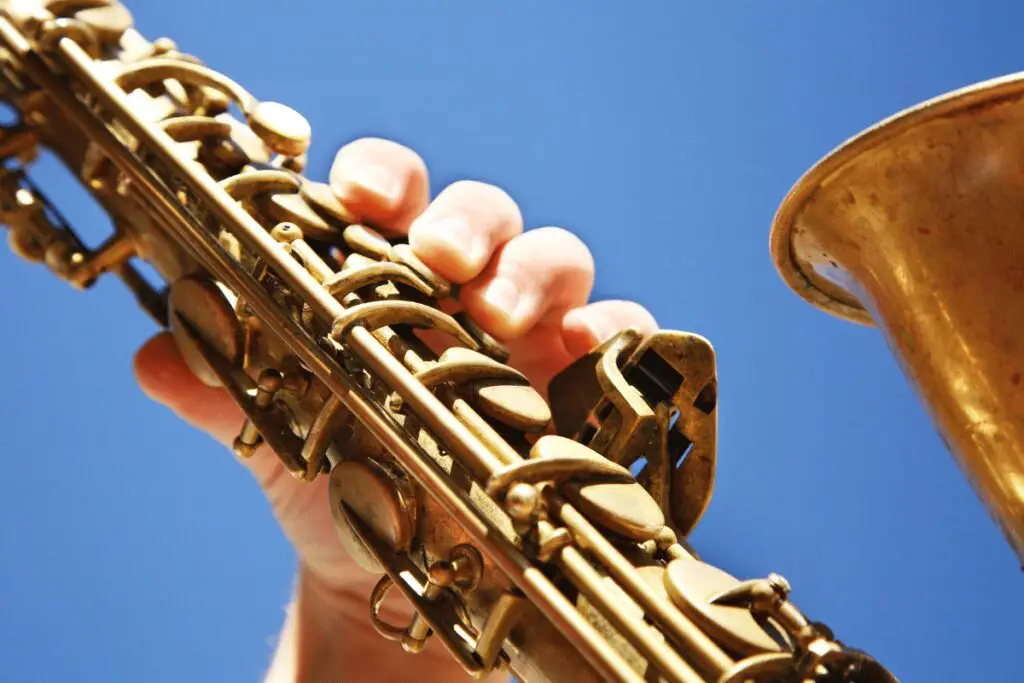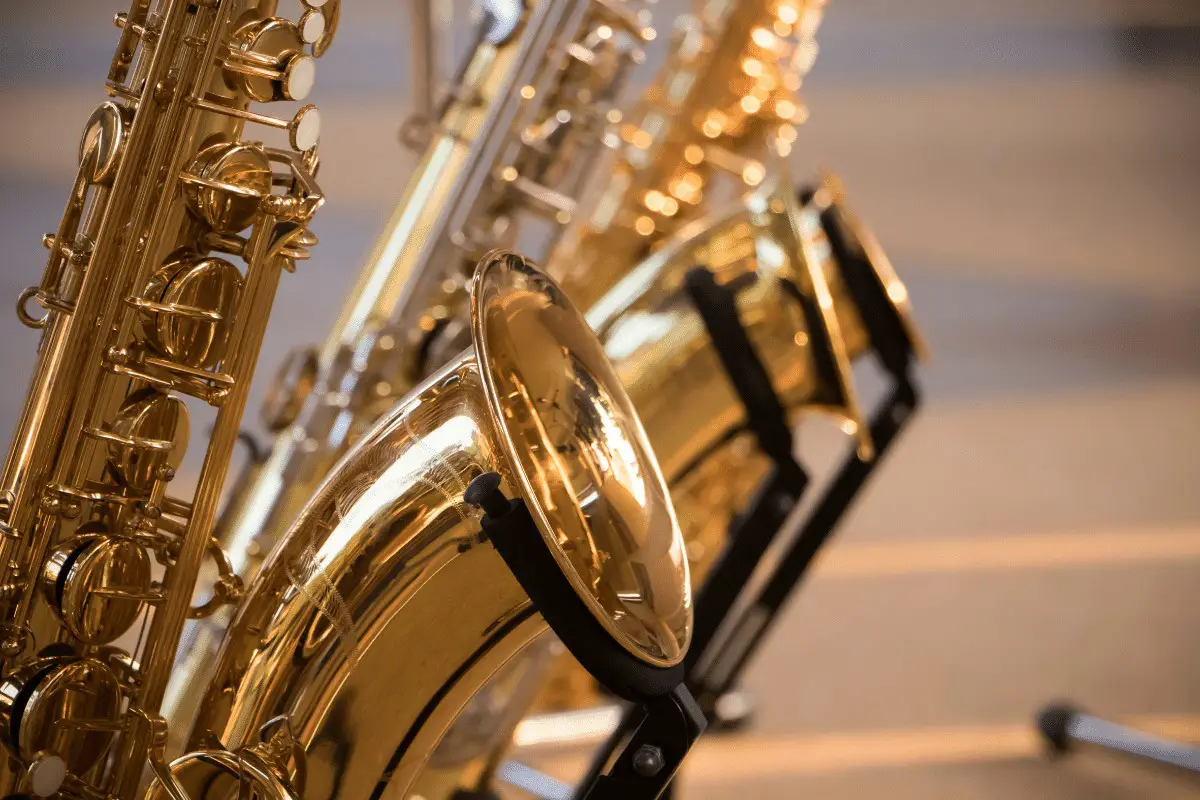Saxophones are one of those instruments that transpose, meaning the notes they see on sheet music isn’t what they play.
As such, it takes a lot for most people to switch the notes back and forth between concert pitch and written pitch.
To add insult to injury, not every saxophone transposes the same way!
If only there was one place to look for a saxophone transposition chart and guide…
Wait! This is exactly what I wanted to do for you in this article, to make your life just a little bit easier.
Look ahead for the quick reference transposition chart and specific information on how to switch back and forth for each saxophone instrument.
Table of Contents
Saxophone Transposition Chart
Before we get into the details on each instrument and how transposing the saxophone works, we’ll give you what you came from right off the bat: the transposition chart for saxophones.
Use this to check how the pitches are related right away and reference the later sections if you want more details and information.
| Concert Pitch (Sounding Pitch) | Key of Eb Written Pitch (Alto, Bari) | Key of Bb Written Pitch (Soprano, Tenor) |
|---|---|---|
| C | A | D |
| C#, Db | A#, Bb | D#, Eb |
| D | B | E |
| D#, Eb | C | F |
| E | C#, Db | F#, Gb |
| F | D | G |
| F#, Gb | D#, Eb | G#, Ab |
| G | E | A |
| G#, Ab | F | A#, Bb |
| A | F#, Gb | B |
| A#, Bb | G | C |
| B | G#, Ab | C#, Db |
Hey! If you found this information helpful, why not share a link to this article on your school website, with your friends, or with your colleagues?
Note: This does not refer to the key signature. Saxes can play in any key; the fingerings just look different from one to another.
What Is Saxophone Transposition?
Saxophone transposition refers to how when you read sheet music for the sax and play a note; it sounds like a different pitch in actuality (called concert pitch). This makes it easier to read the notes and switch between the different types of saxophones.
For most beginner players, you won’t need to know anything about this.
Just know that when you tune an alto saxophone, you play your G, and your tuner shows a Bb.
The tenor saxophone plays a C in order to tune a Bb.
Most instruments are split into two groups:
- Transposing instruments
- Non-transposing instruments
Transposing instruments, like the saxophones, read different notes than what they sound.
Non-transposing instruments always read the pitches that actually come out.
Another word for non-transposing instruments is concert pitch instruments.
As you get better at the saxophone, you’ll need to practice knowing what your notes are in concert pitch as well as your written pitch (what you see on the staff).
Directors won’t always think to tell you what your written pitch is when they’re rehearsing a band, so if you don’t know how to transpose yourself, you may end up confused a lot.
They tend to talk in terms of concert pitch music because it’s easier for them to say it once rather than say it for each transposing and non-transposing instrument.
Also, in talking with the other instruments, there will be confusion between yours and some others if you can’t all talk about the concert pitch.
Alto Sax Transposition

The alto saxophone transposition works in the key of Eb. This means the alto sax plays an Eb concert pitch when it reads a C. To switch from written to concert pitch, move up a minor third (written G moves up to a concert Bb).
Most of the time, you’ll need to think about switching from your written notes to concert pitch, and as mentioned above, the easiest way to do this is to go up a minor third.
A minor third is made of three half-steps or semi-tones.
For example, let’s say we are reading a written E note.
We need to go up a minor third or three half steps.
E -> F -> F# -> G!
Let’s look at another example; now, imagine you’re reading a written F.
A -> A#/Bb -> B -> C!
Sometimes your director or someone will mention they want you to play a note, but they say concert pitch music instead of your transposed one.
In this case, you’ll need to either:
- Reverse the steps and go down a minor third (three half steps).
- Go up a major 6th.
Either option works, and it really depends on what you find the easiest.
Let’s take a look at both methods.
Imagine you need to play a D concert pitch.
Method #1 will have you go down a minor third.
D -> Db/C# -> C -> B!
Method #2 will have you go up a major sixth.
D -> E -> F# -> G -> A -> B!
Either way, we end up with the same note.
For myself, I prefer to use a minor third because it keeps everything the same both ways.
Tenor Sax Transposition
The tenor saxophone transposition works in the key of Bb. This means the tenor sax plays a Bb concert pitch when it reads a C. To switch from written to concert pitch, move down a major second (written C moves down to a concert Bb).
As with the alto, you’ll need to think about switching from written to concert pitch most of the time, and the easiest way to do this is to move down a major second or two half steps.
Let’s look at a couple of examples.
You’re reading an E and want to know the concert pitch.
From here, we go down a major second.
E -> Eb/D# -> D!
Easy, right? Let’s do another one.
Imagine you’re reading an Ab.
Ab -> G -> Gb/F#!
Sometimes your director or someone will mention they want you to play a note, but they say concert pitch instead of your transposed one.
In this case, you’ll need to reverse the steps and go up a major second.
I suppose you could also go down a minor 7th, but that’s needlessly complex.
Here’s an example:
Imagine you need to play a D concert pitch.
Now we go UP a major second.
D -> D#/Eb -> E!
See how the first example in this section is the reverse of this one?
It should always work out like that!
Baritone Sax (Bari Sax) Transposition
The baritone saxophone transposition works in the key of Eb. This means the baritone sax plays an Eb concert pitch when it reads a C. To switch from written to concert pitch, move up a minor third (written G moves up to a concert Bb).
The bari sax is one of the E-flat instruments, just like the alto, so their transposition works the same.
Read the alto section for more specific advice on how to transpose for bari sax.
The tenor and bari saxes also sound in the bass clef range, but to make it easier to read, they all read in treble clef.
Soprano Sax Transposition
The soprano saxophone transposition works in the key of Bb. This means the soprano sax plays a Bb concert pitch when it reads a C. To switch from written to concert pitch, move down a major second (written C moves down to a concert Bb).
The soprano sax is a Bb saxophone, just like the tenor, so their transposition works the same.
Read the tenor section for more specific advice on how to transpose for soprano sax.
B-flat instruments are fairly common in the band and also include the trumpet and clarinet (as well as the euphonium or baritone if the player never learned to read bass clef).
Commonly Asked Questions
Why Do Saxophones Transpose?
The main reasons saxophones transpose are twofold:
- It allows players to switch between saxophone types without needing to learn new fingerings.
- It avoids reading many ledger lines as the notes go up and down.
These main reasons are why we have transposing instruments at all.
Saxes weren’t the first transposing instruments at all.
Learn more in our article on why saxophones transpose.
What Key Is A Soprano Sax In?
The soprano saxophone is a Bb instrument, meaning that when you finger and play a written C, it comes out as a concert Bb.
This makes the soprano saxophone in range, fingering, and purpose very similar to a clarinet, which is also a Bb instrument.
What Key Is A Tenor Sax In?
The tenor sax is a Bb instrument, meaning when it plays a concert Bb, you read a written C.
This is similar to the soprano sax, though the tenor’s range is closer to that of a trombone or euphonium.
Which Saxophone Is Easiest To Learn?
The easiest saxophones to learn are either the alto sax or tenor sax.
Most band teachers start their student saxophone players on the alto because it’s a little easier to hold and requires slightly less air.
Read more in our article on the easiest saxophone to play.
Can A Saxophone Play In Any Key?
A saxophone can play in any key; they just need to use different fingerings to reach all the notes. Just because an alto sax is called an Eb instrument doesn’t mean it can only play in Eb. The “key” of the instrument refers to which sounding pitch is its fundamental.
Key signature and concert key in music refers to how the notes and chords fit together in a piece.
All instruments can play in every concert key.
But when we say the saxophone is a Bb or Eb instrument, it’s more about how it transposes.
A key signature will look different for each instrument depending on what it is, but they can play all of them.
Saxophone players are kind of special in that most of them learn to read two different transposition types, whereas most players only learn one or none at all.

